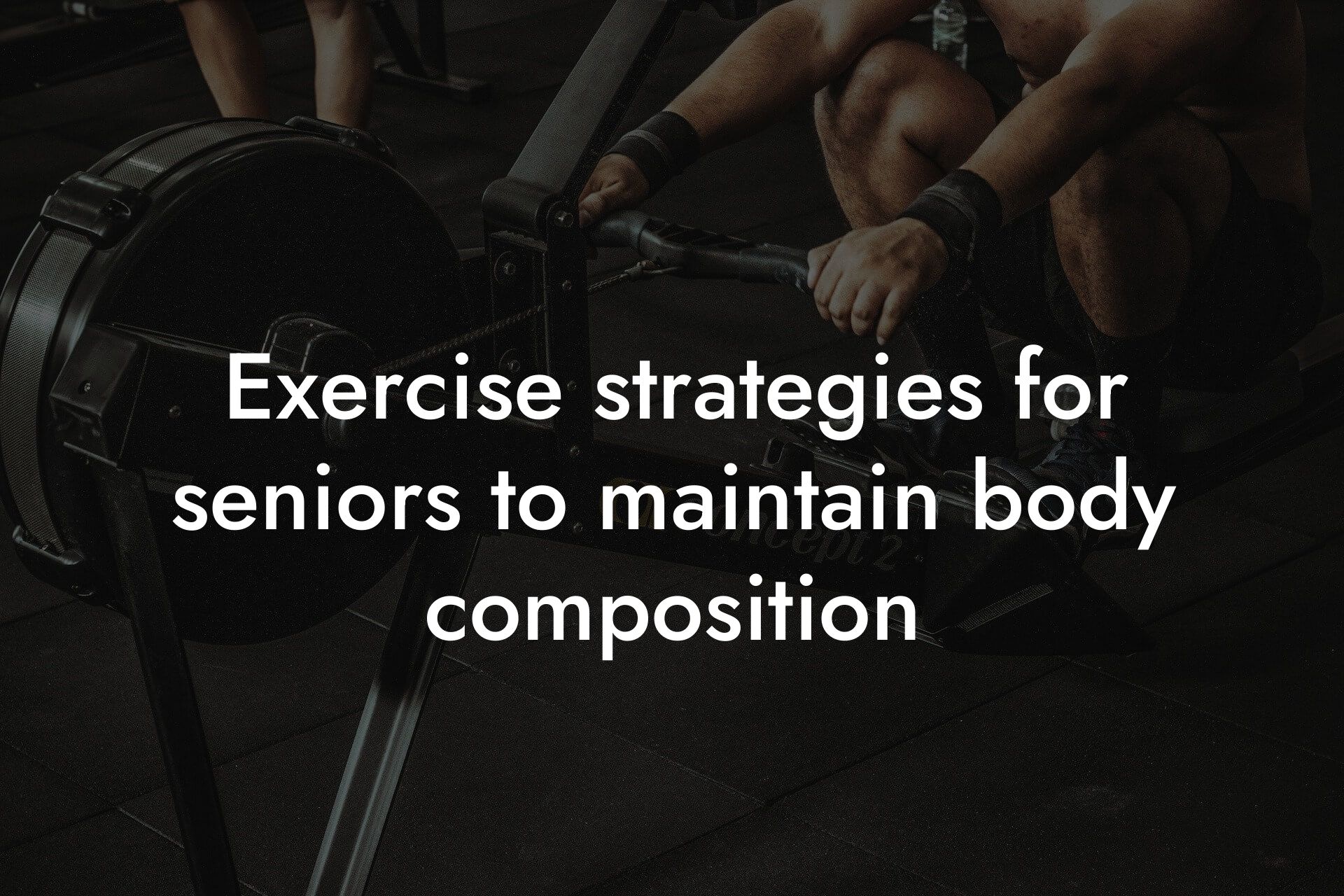As we age, our bodies undergo a range of natural changes that can affect our physical abilities and overall health. However, with the right mindset and strategies, it's entirely possible to maintain an active lifestyle in your 50s and beyond. In this article, we'll explore the importance of staying active, common challenges faced by older adults, and provide practical tips and advice on how to overcome them.
Table of Contents
The Importance of Staying Active
Regular physical activity is crucial for maintaining physical and mental health as we age. Exercise helps to:
- Improve cardiovascular health
- Maintain muscle mass and bone density
- Enhance cognitive function and reduce the risk of dementia
- Boost mood and reduce symptoms of anxiety and depression
- Improve sleep quality
- Increase energy levels and reduce fatigue
In addition to these physical and mental health benefits, staying active can also help older adults maintain their independence, social connections, and overall quality of life.
Common Challenges Faced by Older Adults
Despite the numerous benefits of regular exercise, many older adults face a range of challenges that can make it difficult to stay active. These may include:
- Chronic health conditions, such as arthritis, diabetes, or heart disease
- Injury or surgery, which can lead to reduced mobility and flexibility
- Decreased muscle mass and bone density, making it harder to perform daily tasks
- Changes in body composition, such as increased body fat
- Social isolation and lack of motivation
- Fear of injury or falling
Overcoming Common Barriers to Exercise
While these challenges can be significant, there are many strategies that can help older adults overcome them and stay active. These may include:
- Consulting with a healthcare professional or fitness expert to develop a personalized exercise plan
- Starting slowly and gradually increasing the intensity and frequency of exercise
- Focusing on low-impact activities, such as swimming or cycling, which can be easier on the joints
- Incorporating strength training exercises to improve muscle mass and bone density
- Finding an exercise buddy or joining a fitness group to increase motivation and social connections
- Using technology, such as fitness trackers or apps, to monitor progress and stay accountable
Exercise Options for Older Adults
There are many exercise options that are suitable for older adults, including:
- Brisk walking
- Swimming or water aerobics
- Cycling or using a stationary bike
- Tai chi or other forms of gentle exercise
- Yoga or Pilates to improve flexibility and balance
- Resistance band exercises or light weightlifting to improve strength
It's essential to choose exercises that are enjoyable and tailored to individual fitness levels and goals.
The Role of Nutrition in Maintaining an Active Lifestyle
While regular exercise is crucial for maintaining physical health, nutrition also plays a vital role. A balanced diet that includes plenty of fruits, vegetables, whole grains, and lean protein sources can help:
- Support muscle growth and repair
- Maintain energy levels and reduce fatigue
- Support bone health and reduce the risk of osteoporosis
- Boost immune function and reduce the risk of illness
In addition to a balanced diet, older adults may also benefit from supplements, such as vitamin D or calcium, to support bone health.
Staying Motivated and Tracking Progress
Staying motivated and tracking progress are essential for maintaining an active lifestyle. Strategies for staying motivated may include:
- Setting realistic and achievable goals
- Tracking progress through a fitness journal or app
- Celebrating small victories and milestones
- Finding an exercise buddy or accountability partner
- Rewarding yourself for reaching goals or milestones
In addition to these strategies, regular body composition assessments using a DEXA machine can provide valuable insights into progress and help older adults stay motivated and focused on their goals.
Maintaining an active lifestyle in your 50s and beyond requires a combination of regular exercise, healthy nutrition, and strategies for overcoming common barriers. By understanding the importance of staying active, overcoming common challenges, and incorporating a range of exercise options and nutrition strategies, older adults can maintain their physical and mental health, independence, and overall quality of life.
At Tano Performance Group, we're committed to helping high-earning professionals achieve their fitness goals and maintain an active lifestyle. Our state-of-the-art DEXA machine provides a comprehensive body assessment, giving you the insights you need to take your physical health to the next level. Contact us today to learn more about our services and how we can help you achieve your goals.
Frequently Asked Questions
What are the benefits of staying active in my 50s and beyond?
Staying active in your 50s and beyond can have numerous benefits for your overall health and well-being. Regular physical activity can help improve cardiovascular health, increase strength and flexibility, boost mood, and even reduce the risk of chronic diseases such as diabetes and certain types of cancer. Additionally, staying active can also help improve sleep quality, increase energy levels, and enhance cognitive function.
Is it too late to start exercising if I'm already in my 50s?
Absolutely not! It's never too late to start exercising, regardless of your age. While it's true that our bodies undergo natural changes as we age, regular physical activity can help mitigate these changes and improve overall health. Even small amounts of exercise can make a significant difference, so don't be discouraged if you're new to exercise or haven't been active in a while.
What types of exercise are best for people in their 50s and beyond?
The best exercises for people in their 50s and beyond are those that are low-impact, gentle on the joints, and focus on improving flexibility, balance, and strength. Examples include yoga, Pilates, swimming, cycling, and brisk walking. It's also important to incorporate exercises that target core strength, as this can help improve balance and reduce the risk of falls.
How often should I exercise to see results?
Aim to exercise at least 3-4 times per week, with at least one day of rest in between. This can be broken down into 30 minutes of moderate-intensity exercise per session, or 15-20 minutes of high-intensity exercise per session. Consistency is key, so find a routine that you enjoy and can stick to in the long term.
What if I have a pre-existing medical condition? Can I still exercise?
Yes, but it's essential to consult with your healthcare provider before starting any new exercise program, especially if you have a pre-existing medical condition. They can provide guidance on safe exercises, intensity levels, and any necessary modifications or precautions.
How can I stay motivated to exercise regularly?
Staying motivated to exercise regularly can be challenging, but there are several strategies that can help. Find an exercise buddy or join a fitness group to provide accountability and social support. Set specific, achievable goals and reward yourself when you reach them. Vary your exercise routine to avoid boredom, and track your progress to see how far you've come.
What if I'm new to exercise? Where do I start?
If you're new to exercise, start by consulting with your healthcare provider to get clearance and guidance. Then, begin with short, gentle exercises and gradually increase intensity and duration as you become more comfortable. Consider working with a personal trainer or fitness coach who can provide guidance and support.
How can I incorporate physical activity into my daily routine?
Incorporating physical activity into your daily routine can be easier than you think. Try taking the stairs instead of the elevator, walking to work or during your lunch break, or doing a few jumping jacks during commercial breaks while watching TV. Every bit counts, and small amounts of physical activity can add up to make a big difference.
What are some exercises that can help improve bone density?
Exercises that can help improve bone density include weight-bearing activities such as walking, running, and jumping, as well as resistance training exercises that target the major muscle groups. Examples include squats, lunges, and leg press exercises.
How can I reduce my risk of injury while exercising?
To reduce your risk of injury while exercising, start slowly and gradually increase intensity and duration. Warm up before exercising and cool down afterwards to prevent muscle strain. Listen to your body and rest when needed, and avoid exercising when you're tired or in pain.
What are some exercises that can help improve flexibility?
Exercises that can help improve flexibility include yoga, Pilates, and stretching exercises that target the major muscle groups. Examples include hamstring stretches, quadriceps stretches, and chest stretches.
How can I stay active during the winter months?
Staying active during the winter months can be challenging, but there are several strategies that can help. Try indoor exercises such as yoga, Pilates, or bodyweight exercises. Consider joining a fitness class or working with a personal trainer to provide motivation and accountability. You can also invest in home fitness equipment such as a treadmill or stationary bike.
What are some exercises that can help improve balance?
Exercises that can help improve balance include single-leg squats, heel-to-toe walking, and balance exercises that target the core muscles. Examples include planks, side planks, and bird dog exercises.
How can I track my progress and stay accountable?
Tracking your progress and staying accountable can be motivating and help you reach your fitness goals. Consider using a fitness tracker or mobile app to track your exercise routine, or work with a personal trainer or fitness coach who can provide guidance and support.
What if I have a busy schedule? Can I still find time to exercise?
Yes, even with a busy schedule, it's possible to find time to exercise. Try breaking up your exercise routine into shorter sessions throughout the day, or find exercises that can be done in just a few minutes, such as bodyweight exercises or jumping jacks.
How can I stay hydrated during exercise?
Staying hydrated during exercise is essential to prevent dehydration and improve performance. Aim to drink at least 8-10 glasses of water per day, and make sure to drink water before, during, and after exercise.
What are some exercises that can help improve cardiovascular health?
Exercises that can help improve cardiovascular health include aerobic exercises such as brisk walking, jogging, cycling, and swimming. High-intensity interval training (HIIT) can also be effective for improving cardiovascular health.
How can I incorporate strength training into my exercise routine?
Incorporating strength training into your exercise routine can help improve overall health and fitness. Aim to do strength training exercises at least 2-3 times per week, targeting all major muscle groups. Examples include squats, lunges, push-ups, and rows.
What are some exercises that can help improve cognitive function?
Exercises that can help improve cognitive function include aerobic exercises such as brisk walking, jogging, and cycling, as well as exercises that challenge the brain such as puzzles, brain teasers, and strategy games.
How can I stay active during vacations or travel?
Staying active during vacations or travel can be challenging, but there are several strategies that can help. Try to incorporate physical activity into your daily routine, such as walking or jogging in the morning, or doing bodyweight exercises in your hotel room. You can also research local fitness classes or gyms in your destination.
What are some exercises that can help improve sleep quality?
Exercises that can help improve sleep quality include gentle exercises such as yoga, Pilates, and stretching, as well as aerobic exercises such as brisk walking and cycling. Avoid vigorous exercise within a few hours of bedtime, as this can interfere with sleep.
How can I stay motivated to exercise during the holidays?
Staying motivated to exercise during the holidays can be challenging, but there are several strategies that can help. Try to schedule exercise into your daily routine, and find exercises that you enjoy. You can also work with a personal trainer or fitness coach to provide motivation and accountability.
What are some exercises that can help improve overall health and wellness?
Exercises that can help improve overall health and wellness include aerobic exercises such as brisk walking, jogging, and cycling, as well as strength training exercises that target all major muscle groups. Additionally, exercises that improve flexibility, balance, and cognitive function can also contribute to overall health and wellness.
Here are some related articles you might love...
- Exercise strategies for seniors to maintain body composition
- Longevity supplements: What works?
- How to maintain bone density as you age
- The impact of aging on muscle mass
- Anti-inflammatory diets and their effect on aging
- The impact of aging on metabolic rate
- The role of telomeres in aging and fitness
- Sarcopenia: Preventing muscle loss with age
- Anti-aging diets: Fact or fiction?
Zak Faulkner
Zak Faulkner is a leading authority in the realm of physical health and body composition analysis, with over 15 years of experience helping professionals optimise their fitness and well-being. As one the experts behind Tano Performance Group, Zak has dedicated his career to providing in-depth, science-backed insights that empower clients to elevate their physical performance and overall health.
With extensive knowledge of DEXA technology, Zak specializes in delivering comprehensive body assessments that offer precise data on body fat, muscle mass, bone density, and overall physique. His expertise enables individuals to make informed decisions and achieve their fitness goals with accuracy and confidence. Zak’s approach is rooted in a deep understanding of human physiology, combined with a passion for helping clients unlock their full potential through personalised strategies.
Over the years, Zak has earned a reputation for his commitment to excellence, precision, and client-focused service. His guidance is trusted by top professionals who demand the best when it comes to their health. Whether advising on fitness programs, nutritional strategies, or long-term wellness plans, Zak Faulkner’s insights are a valuable resource for anyone serious about taking their health and fitness to the next level.
At Tano Performance Group, Zak continues to lead our Content Team revolutionising how professionals approach their physical health, offering unparalleled expertise that drives real results.




